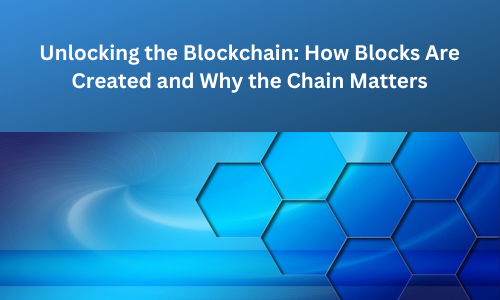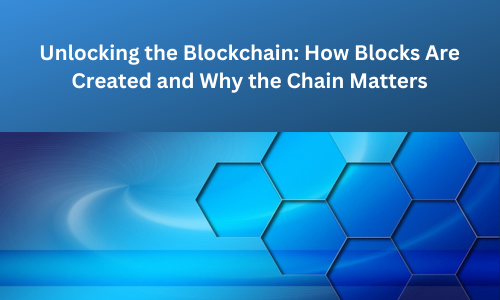


Blockchain technology is often hailed as one of the most revolutionary innovations of the 21st century. Yet, the inner workings of how it functions can seem like a mystery. In this article, we’ll break down the process of how blocks are created on the blockchain and delve into the critical role the chain plays in ensuring security, transparency, and trust in this decentralized system.
At its core, blockchain is a decentralized and distributed ledger technology that records transactions across multiple computers. Unlike traditional databases controlled by a central authority, blockchain relies on a network of participants to verify and record transactions, ensuring data integrity and transparency.
A blockchain is made up of two key components: blocks and chains. A block is essentially a digital container that holds a list of transactions or data. Each block contains a unique identifier known as a cryptographic hash, which not only secures the block but also links it to the previous block in the chain. This creates a continuous, unbreakable sequence of blocks—a chain—hence the name "blockchain."
The creation of blocks is a systematic process that involves several critical steps:
1. Transaction Collection
The journey begins when a user initiates a transaction on the blockchain network. This transaction could be anything from transferring cryptocurrency to executing a smart contract. Once initiated, the transaction is broadcasted to the network, where it awaits verification.
2. Block Formation
These pending transactions are grouped together by network participants, known as nodes, into what will become a new block. However, before a block is officially added to the chain, it must undergo a process of consensus to ensure that all transactions within it are legitimate.
3. Consensus Mechanism
Blockchain networks use various consensus mechanisms to validate and add new blocks. The two most popular methods are Proof of Work (PoW) and Proof of Stake (PoS).
Proof of Work (PoW): In PoW, miners compete to solve complex mathematical puzzles. The first miner to solve the puzzle gets to add the new block to the blockchain and is rewarded with cryptocurrency. This process, while secure, is energy-intensive and time-consuming.
Proof of Stake (PoS): PoS takes a different approach by selecting validators based on the amount of cryptocurrency they hold and are willing to "stake" as collateral. Validators are chosen at random, making the process more energy-efficient and scalable.
Other consensus mechanisms, like Proof of Authority (PoA) or Delegated Proof of Stake (DPoS), also exist, each with its own unique approach to maintaining the integrity of the blockchain.
4. Block Validation
Once a block is formed and passes the consensus check, it must be validated by the network. This involves verifying the authenticity of each transaction within the block and ensuring that it adheres to the network's rules.
5. Adding the Block to the Chain
After successful validation, the block is added to the blockchain, becoming an immutable part of the ledger. Each block contains the cryptographic hash of the previous block, creating a secure link between them and solidifying the integrity of the chain.
So why is this chain of blocks so important? The answer lies in the unique properties it imparts to the system:
1. Immutability
One of the most significant advantages of blockchain technology is its immutability. Once a block is added to the chain, the data within it cannot be altered or deleted. This ensures that all records on the blockchain are permanent and tamper-proof.
2. Security
The cryptographic hash that links each block to its predecessor plays a crucial role in securing the blockchain. If a malicious actor attempts to alter the data in a block, they would need to change the hash of that block and all subsequent blocks—a nearly impossible feat, especially in large and decentralized networks.
3. Transparency and Trust
Blockchain's decentralized nature means that no single entity has control over the entire system. All transactions are transparent and can be verified by anyone in the network, fostering trust without the need for intermediaries.
4. Decentralization
Unlike traditional databases, which are often centralized and vulnerable to attacks, blockchain operates on a decentralized network of nodes. This lack of a single point of control enhances the system's security and reliability, making it resistant to censorship and fraud.
Blockchain’s potential extends far beyond cryptocurrencies like Bitcoin and Ethereum. It’s being used in various sectors to improve efficiency, security, and transparency.
Cryptocurrency: Blockchain is the backbone of digital currencies, enabling secure and decentralized transactions without the need for banks.
Smart Contracts: These self-executing contracts automatically enforce the terms of an agreement when certain conditions are met, reducing the need for intermediaries.
Supply Chain Management: Blockchain helps track the movement of goods, ensuring transparency and accountability in supply chains.
Digital Identity: Blockchain can provide secure and verifiable digital identities, reducing fraud and improving access to services.
Despite its advantages, blockchain faces challenges such as scalability issues, particularly with older consensus mechanisms like PoW, which are resource-intensive. Solutions like sharding and Layer 2 technologies are being explored to overcome these limitations.
Energy consumption is another concern, particularly with PoW systems, but newer consensus mechanisms like PoS aim to reduce the environmental impact. Adoption and regulation also present hurdles as industries and governments grapple with the implications of this disruptive technology.
Blockchain technology represents a paradigm shift in how we think about data security, transparency, and trust. The process of creating blocks and linking them together into an immutable chain is central to the integrity of this system. As blockchain continues to evolve, its applications are set to expand, potentially transforming industries and changing the way we interact with the digital world.
Disclaimer: This article is provided for informational purposes only. It is not offered or intended to be used as legal, tax, investment, financial, or other advice.
